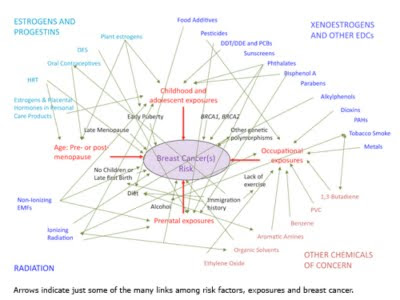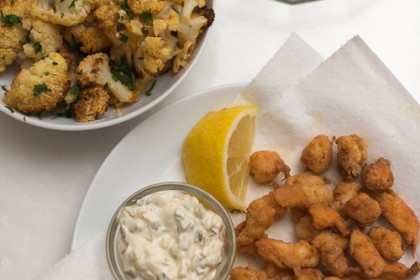
This is a chart was created by the breastcancerfund.org. It shows how many environmental factors impact breast cancer risk and “the complexity of breast cancer causation”. Minimizing exposure to xenoestrogens is critical for anyone who wants to reduce risk for breast cancer, which 1 in 8 women will be diagnosed with during their lifetime. Although the research has been focused on breast cancer, xenoestrogens which disrupt hormones are not good for anyone, especially children who are developing. For more information on the connection go to breastcancerfund.org.
Xenoestrogens are found in food additives, pesticides, sunscreens, plastics that contain phthalates, parabens and metals. By avoiding products that contain these xenoestrogens, the public will be forcing manufacturers to produce safer products. Don’t be fooled by green advertising–read labels! Bisphenol A (BPA) recently found in older SIGG bottles lined with plastic was originally being researched as a synthetic estrogen. When other estrogens came along they discovered it helped to soften plastic. So if you haven’t gotten around to returning your SIGG bottles to the manufacturer this is a good place to start!
Choose ONE THING you can do to lessen your exposure to xenoestrogens and incorporate into your families life. When that becomes routine make another change.
Here are some ideas:
• Don’t drink from a plastic bottle–use glass, stainless steel cups or buy a Klean Kanteen stainless steel bottle.
• Seek out safer plastics…use number 1, 2, 4 and 5 on the bottom of the container/avoid 3, 6 and 7
• Go to LifeWithoutPlastic.com for non plastic options
• Avoid triclosan–an ingredient in antibacterial soap
• No more microwave popcorn–make it the old fashioned way with a stainless steel pot on the stove with oil and a lid.
• Avoid teflon products, pans and clothing (like gore tex)
• Look for paints with no VOC (like Mythic paint)
• Read food labels and “go back to the 18th century–if your grandmother wouldn’t recognize it as food–don’t eat it.” This will reduce your exposure to dyes and additives.




Karen Joy - For popcorn, get a Whirley Pop!! Seriously. My mom got it for me for Christmas (actually, she got me something else, but I traded with my older brother, as we each liked each other's gifts) http://popcornpopper.com/24000.html
It seriously takes about 3 minutes from start to finish to make some stovetop-popped popcorn. We use ours 2-4x/week!
Kathy - This is very important information.
My daughter also talks about this
issue. She is in biochemistry, and
is quite concerned about the estrogen
effects of plastic as well. Thank you for helping to get the word out.